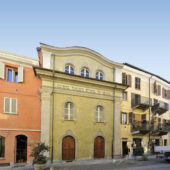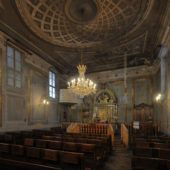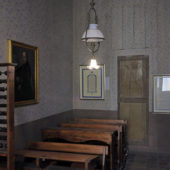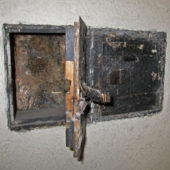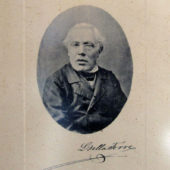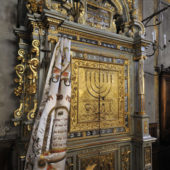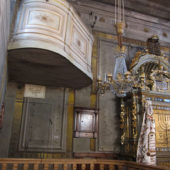This fine Baroque synagogue survived a direct hit by a bomb which didn’t explode.
The Synagogue of Cuneo is the oldest of the sixteen synagogues still in existence in the Piedmont area in Italy. Most of its Orthodox congregants have been Sephardic; however, much of its history is unknown.
The town of Cuneo was founded in 1198 and became known for the seven sieges it has endured. It was the capital of its province and sits in an area between two rivers that cross in a ‘v’ shape, which both flow from the Alps. The land the town is situated on is shaped as a ‘v’ or ‘wedge,’ and the Italian word for ‘wedge’ is ‘cuneo,’ hence the name for the town. Originally, it was fortified with walls, due to its proximity in guarding the Tenda and Maddalena passes into France. In 1797 Napoleon’s army overtook Italy for a short period, during which time, Napoleon instructed his men to tear down the walls of Cuneo.
In 1555 Pope Paul IV declared that Jews were not fit to live with Christians. As a result, the Jews of Cuneo had to live in ghettos. The ghetto in Cuneo was comprised of a single street, which was shorter than the average New York City block, where approximately 300 Jews lived. These were productive people: scientists, bankers, poets and rabbis, who daily would go forth from this ghetto and perform their occupations, often for gentiles. The synagogue was built in 1611 in the heart of the ghetto.
The façade of the Synagogue is understated Baroque, with sweeping lines, arched windows and doors. Upon entering the prayer room, one is struck by its subdued grandeur – the grey walls highlighted with gilding, stenciled gilded designs, and scriptures in Hebrew inscribed in the intricate cornicing surrounding the entire room, as well as the stunning decorative moldings on the ceiling.
On one wall there is a plaque from the original synagogue dated 1611. Embedded in the wall near the plaque is an unexploded cannon ball which fell on the synagogue in 1779, when Napoleon attacked the city. The cannon ball was placed in the synagogue to celebrate the fact that since the “bomb” did not explode, the Jews were unharmed and the synagogue was not destroyed. This happy event is known as “the Purim of the bomb.”
Candelabras adorn the walls and there are two sets of paned windows on the two side walls of the prayer room. The bimah and ark are on a raised platform at the East end of the prayer room, which can be entered from either side, up a few steps. There is a wooden balustrade across the front of the platform. The ark is carved from wood in Venetian Baroque style and lavishly gilded. The podium and baldachin for the Rabbi are also on the platform. This is unusual for an Italian synagogue; where typically the ark and bimah would be on opposite walls. According to local sources, after 1848 when Jews received equality, they wanted to be more like everyone else. And they wanted their synagogues to look more like churches. So, they built them without a bema in the middle. They also added a pulpit (in Cuneo it is on the left side as you face the Ark). However, the rabbis didn’t use the pulpit.
On the first floor, the synagogue boasts a library, filled with ancient texts in Hebrew. It also has an old mikveh (ritual bath) and matzo oven. A recreation room and a media room for showing films are being added. There are plans to build a small kosher kitchen, as well as to renovate the mikveh and matzo oven, not for use, but to show visitors how these used to work.
In 1910-20, the peak years, the Jewish population of Cuneo was approximately 200-250. During the Holocaust, though there were problems, of course, most of the Jews of Cuneo were saved from death. Many were hidden by local townspeople; others hid in the mountains. About 1000 people fleeing France, Austria and Germany came to Cuneo. Many of these also escaped the camps by hiding in the mountains. However, 350 were captured and taken to the nearby village of Bargo san Dalmazzo. From there they were put on trains to Auschwitz. There were no survivors from this group.
Today, there are only approximately 16 or 17 Jews in Cuneo. They are proud of their synagogue, their city, and all that “being Jewish” means to them. Although the congregation at Cuneo is small, they are intent upon keeping Jewish culture, traditions and faith alive.

